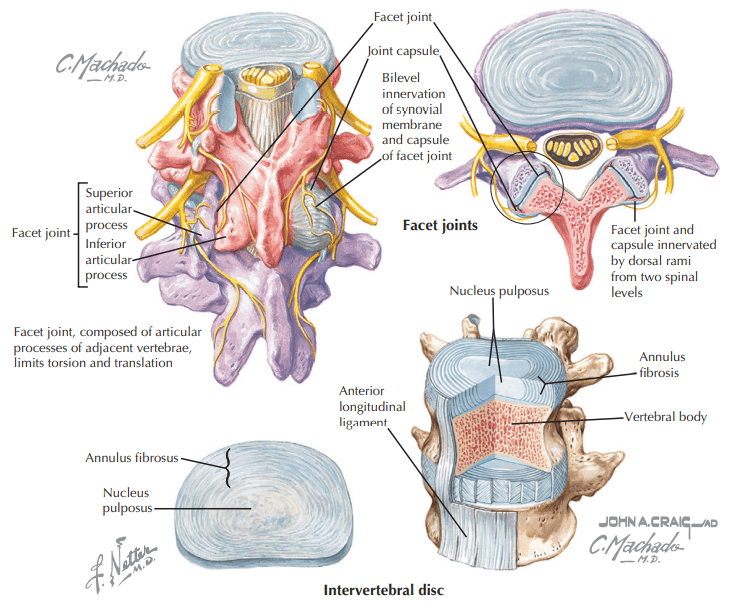When seeking care for low back pain, a Fredericksburg chiropractor should be the first stop. There are many causes of low back pain and a Fredericksburg chiropractor aims to identify the correct cause and correct it before it creates a chronic condition. The second most common condition that creates low back pain, according to the literature, is Facet syndrome. With the most common being disc injury.
Facet syndrome and low back pain?
Facet syndrome is a condition of the joints in the spine, these joints are specifically called facet joints. These joints are responsible for the motion throughout the spine and start at the base of the skull and continue all the way down to the base of the tailbone. There are over 100 of these joints and they are positioned on both the right and left sides of the spine. This can be the reason why some of your back pain seems to alternate sides dependent on the day or time. These joints are susceptible to injury if overused or repetitively jammed with heavy loads or repetitive extensions.
Creep deformity, Hysteresis, and low back pain.
These joints also have supporting structures like ligaments that can become injured if used too frequently or are overloaded frequently by sustained postures for prolonged periods of time. The two types of injury of these supporting ligaments are related to the deformation properties of creep and hysteresis.
The first term creep deformity pertains to the ligaments losing their ability to return to their normal state when the elastic structure is under a constant load for a longer period of time then the elastic structure can sustain. An example of this would be bending at the waist to pull weeds for a prolonged period of time not keeping the spine in its neutral. This puts constant load on the elastic ligaments and they stretch and lengthen under the sustained load creating injury.
Hysteresis deals with the same elastic ligaments but instead of constant load, it is repetitive load and unload. Such as repetitive tasks like moving boxes during a move. The constant repetitive bend and relaxation loads and unloads these elastic ligaments making them weaker and damaged.
The facet joints as it pertains to facet syndrome are innervated by a very small sensory nerve that tells the brain constantly about the integrity of the facet joint as well as its supporting ligaments. These little nerves also send information to the brain about posture and positional senses.
While these nerves are sensory from the joint to the brain, they are also motor nerves from the brain to the spines postural muscles. So this creates a situation where anything that affects the joint like injury to the joint or ligaments, creates an irritation to these little nerves that affects sensory and ultimately postural tone. As the nerves are irritated from injury they also create a motor response that tightens all postural muscles in the area. This can create the feeling of muscle spasm or tightness that the patient sees as a “pulled muscle” or “muscle strain”.
This is only partly true as the real injury is at the joint level and the brain produces the postural muscle tightening to splint the joint up or offer increased stability during the injured state. This leaves the individual thinking that the pain is just “muscular” and that massage and stretching are necessary. While these tend to help, their effects can be short if the joint dysfunction or damage is not treated. The muscle tightness is just the symptom and in most cases, not the cause.

The facet joints and their supporting structures or ligaments. The nerves that give sensory to the joints are the dorsal primary ramus nerves.
What does facet syndrome feel like, its not always just low back pain?
Facet syndrome can feel like many different things as seen by a Fredericksburg chiropractor. It includes:
- Stiff dull achy low back pain as you arise in the morning, and gets better the more you move around.
- Groin, hip, buttock, or knee pain.
- Stiffness, muscle spasm, sharp stabbing low back pain, or sharp stabbing pain in the areas listed above when moving wrong.
- It can even give you pains that seem to be deep in the pelvis or otherwise seemingly unrelated to the lower back.
Facet syndrome typically is a dull achy type of pain that can get to a sharp sensation if you move wrong. These conditions tend to be the most troublesome if you have a job where you have to keep one position for prolonged periods like sitting or standing. Facet syndrome seems to be worst with prolonged standing rather than sitting though, however, getting up after a prolonged sitting can be particularly uncomfortable for these individuals. They may even feel like it takes them a few steps in order to straighten up.
Facet syndrome gets better with motion like walking due to the recruitment of the joints primary stabilizers, the muscles. It is worse with prolonged positions because the muscles aren’t being used to stabilize the joints as much and we rely on the ligaments more. If these ligaments are injured then it will create pain. The brain, knowing that the muscles are the best joint stabilizers, will use the muscles without the individual’s conscious effort. This creates the sensation of muscle tightness and stiffness.
Whether it is the facet joint itself that is injured or its associated structures like the ligaments, the response from the brain is the same. Muscle tightness and stiffness that can make them feel fatigued or overworked.
How can a Fredericksburg chiropractor help?
A Fredericksburg chiropractor can utilize many different techniques to alleviate your low back pain. At Stine Chiropractic Clinic, all providers are board certified chiropractic orthopedists. The use of physical exam is necessary to diagnose the current condition as facet syndrome or something else. The condition will be explained to you as well as things to do at home to help. Using physical therapy modalities like interferential TENS aids with pain reduction through the release of endorphins and enkephalins, which are the body’s own painkillers, and help with making you as comfortable as possible for treatment. The use of spinal manipulation is used to increase the motion through the injured joint to allow for nutritional exchange by replenishing the fluid that bathes the joint, called synovium. Without this movement, your body is not going to be very effective at delivering the nutrition necessary to the joint for healing.
How long does it take to heal?
Healing is patient dependent and is based off of many different factors like underlying conditions or degenerative changes that may complicate responses. This is why your Fredericksburg chiropractor may do plain film x-rays of the area creating your lower back pain. This is to evaluate the area for any arthritis, degeneration, or congenital (present from birth) abnormalities that can complicate healing. Following the treatment program prescribed to you by your Fredericksburg chiropractor or chiropractic orthopedist is important. Each visit builds on the past and can take 2-4 weeks of treatment to start feeling large improvements. Small improvements can be present from the first visit but are usually short lived returning later that day or the next, until the next visit. Continued treatment delivered through the treatment plan allows for longer and longer relief as the injured structures start to heal and the body starts to recognize this. A considerable amount of improvement in some cases may be experienced immediately and in most cases 2-3 weeks of treatment.
When is the best time to seek treatment for low back pain?
Getting in to see a Fredericksburg chiropractor for low back pain should be done as soon as possible so that the cause of the pain can be determined. Once determined, treatment can begin immediately. Seeing a Fredericksburg chiropractor that specializes in conservative orthopedics is always a good choice.







